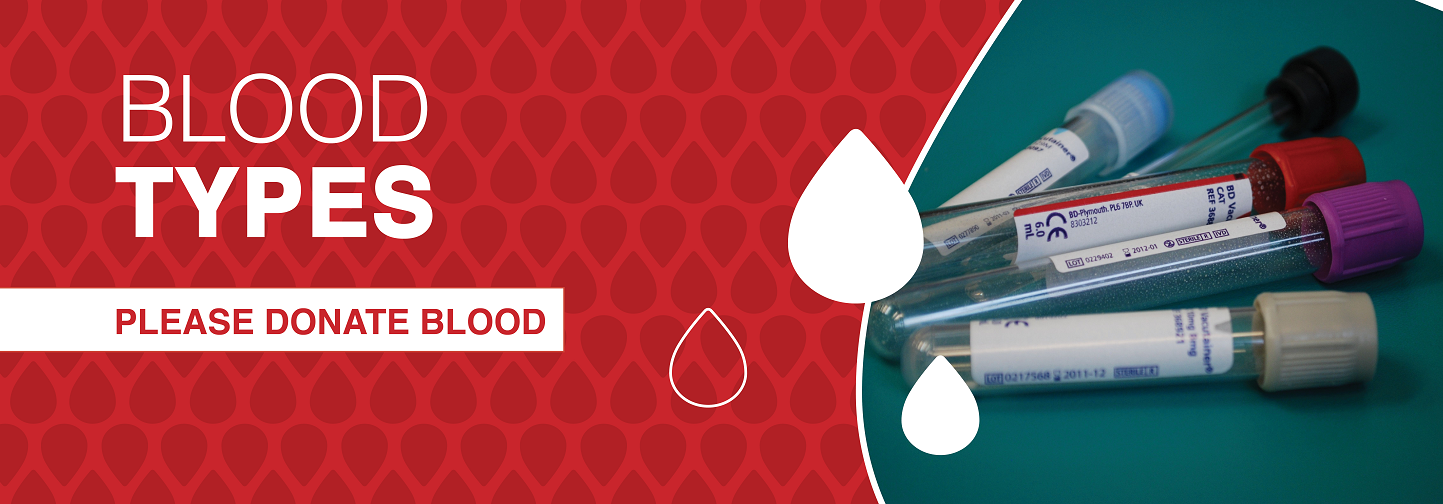Blood Types
Every person belongs to one of eight blood groups. These blood groups, or blood types, are sub-types of the four larger ABO blood groups – A, B, AB or O. The Rhesus (Rh) system further divides these four groups into either Rh+ or Rh-, leaving eight blood types: O-, O+, B-, B+, A-, A+, AB- or AB+. The most common blood type is O+, and the rarest is AB-. Which one are you?
Blood group compatibility
Not all blood types are compatible. This is due to the differences in antibodies that occur in different blood types. While blood group A individuals have naturally occurring anti-B blood group antibodies in their plasma, blood group B has anti-A blood group antibodies and blood group O has anti-A and -B blood group antibodies.
So, for example, if a blood group B patient is given blood group A, the anti-A antibodies in their plasma will destroy the red cells in the transfused unit and lead to severe complications or even death.
Which types are compatible?
Universal donors and recipients
Blood group O individuals are known as "universal donors". They lack A and B blood group antigens which makes it possible for their blood to be given to all ABO types. AB+ blood group individuals on the other hand are known as "universal recipients". They lack naturally occurring anti-A and -B and can receive all ABO groups.
The biology of blood
ABO blood grouping is determined by the correlation of visible clumping in mixtures of plasma, the liquid component of blood, and the red cells, which carry oxygen. The Rhesus system, first discovered in 1939, relies on the presence of antigens – the D antigen in particular. Antigens are molecules that bind to an antibody. A person either has or hasn’t got the Rh factor (D antigen) on the surface of their red cells, indicating a positive (Rh+) or negative (Rh-).
Rare blood types
Occasionally an individual is born with an unusual, specific red-cell antigen, or without an antigen that is common to most people. These differences are recognised as rare blood types and are difficult to match with regular blood groups due to antibody presence.
Blood components
Our blood naturally consists of various components. The main components are:
- Plasma
- Platelets [ image : blood components ]
- Red blood cells
Red Blood Cells
- This component gives blood its red colour and accounts for up to 40% of its volume.
- These cells carry oxygen from the lungs to all the cells of the body.
- Red cells have a ‘shelf life’ of up to 42 days if stored correctly.
Platelets
- This component assists the blood with its clotting process.
- They are literally tiny plates that wedge together covering tears in the blood vessels and preventing blood from leaking into surrounding tissue.
- Platelets are stored at room temperature and have a shelf life of only 5 days. This is why it is vital to have a constant flow of blood donations coming in..
Plasma
- This is the straw coloured fluid in which the red cells, white cells and platelets are suspended.
- It contains very important nutrients and clotting factors which help to prevent or stop bleeding.
- Plasma is stored frozen and has a shelf life of up to 12 months.
What are the different blood types?
Everybody has a particular blood type which his jointly inherited from their mother and their father. There are two major blood typing systems – the ABO system and the Rhesus system (Rh factor positive or negative) – the different combinations of which result in 8 major blood types (A+, A-, B+, B-, AB+, AB-, O+, O-). When a transfusion is required, it is preferable that the patient receive blood of the same ABO and Rh type. However, in an emergency, if the required blood type is unavailable, a patient may be given blood of a different, but compatible type.
What are the different components of blood and what do they do?
1.Red cells give blood its colour and account for 40 – 50% of its volume.
- Their main function is to carry oxygen from the lungs to all the cells of the body and remove waste products such as carbon dioxide.
- Transfusions are used to treat people with severe anaemia, those whose red blood cells do not function adequately and people experiencing severe bleeding such as accident victims and patients undergoing surgery.
- Red cells are stored in a refrigerator and have a shelf life of up to 42 days.
- The body replaces red cells (and iron) within 36 – 52 days. That’s why you’re only allowed to donate again after 56 days.
2. Platelets are components of blood that assist in the blood clotting process.
- They are literally tiny plates that wedge together covering tears in the blood vessels and preventing blood from leaking into surrounding tissue.
- The primary use of platelets is in the treatment of people with various cancers and other diseases such as leukaemia where the bone marrow is unable to produce adequate numbers of platelets, as well as for people receiving medical treatments like chemotherapy which can decrease a person’s platelet count. Platelets are also used to treat people suffering severe blood loss.
- Platelets are stored at room temperature and have a shelf life of only 5 days. This is why it is vital to have a constant flow of donations coming in through specialised platelet donations (apheresis donations).
- The body quickly replenishes plasma and platelets within 2 – 3 days. This process is encouraged by the intake of fluids after blood donation.
3. Plasma is the straw coloured fluid in which the red cells, white cells and platelets are suspended.
- Plasma is the most versatile component of blood as it can e processed into a variety of products and each product can be used to treat a number of potentially life-threatening conditions.
- Plasma is stored frozen and has a shelf life of up to 12 months.
- The body quickly replenishes plasma and platelets within 2 – 3 days. This process is encouraged by the intake of fluids after blood donation.
How much blood will I give?
A single unit of blood taken during a whole blood donation is approximately 475 ml (less than half a litre), which is less than 10% of your total blood volume. Your body keeps on replenishing blood all the time whether you give blood or not, so this amount is quickly replaced. Plasma is replaced within 2 – 3 days, platelets
How much blood does an adult body have?
An average size adult has a blood volume of around 4.5 – 5.5 litres.
What will happen to my blood after I have donated?
Every single donation is tested for HIV, Hepatitis B and C, and Syphilis and the blood group is determined. Only safe blood that tests negative for all abnormalities is then divided into its constituent parts and transformed into blood products. These products are stored accordingly, after which they are issued to blood banks which are located across Namibia and issued to patients according to their specific medical requirements.

